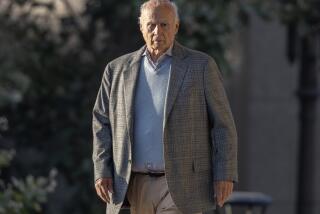THE SIMPSON TRIAL : Cases of Feuding Lawyers Seldom Reach the Public Eye
NEW HAVEN, CONN. â Word that the feud between Simpson attorneys Robert L. Shapiro and F. Lee Bailey has ended, and that Johnnie L. Cochran Jr. will be âlead counselâ in âcharge of overall strategy,â may be the last we hear of conflicts among Simpsonâs lawyers, but it will not be the end of their disagreements. When a diverse and independent group of lawyers is put together to defend a specific case, rifts are commonplace.
Criminal-defense prima donnas are notorious for their unwillingness or inability to cooperate with co-counsel. Clarence Darrow was constantly squabbling with co-counsel and changing strategies without consulting them.
In one of the most publicized cases earlier this century, Darrow and another prominent lawyer, Edmund Richardson, headed a team of 16 lawyers defending William (Big Bill) Haywood and two other labor leaders against charges of murdering ex-Gov. Frank Steunenberg of Idaho. Darrow and Richardson were âon equal footingâ as chief counsel. They proceeded to present inconsistent defenses to the jury, Richardson claiming the defendants were framed, Darrow imply- ing that they were justified.
After the trial, Richardson publicly denounced Darrow for âpreaching socialismâ rather than âtrying a case.â But at least Richardson waited until the trial was over.
When Darrow himself was on trial in Los Angeles for bribing a jury, he hired Earl Rogers, Californiaâs premier trial lawyer, to defend him. Both lawyers participated in the defense and were in constant disagreement about strategy. They were at least able to keep it largely to themselves, and Darrow was acquitted. But the disagreements between the two lawyers had been so fractious that Rogers was not asked to participate in Darrowâs defense of a second indictment. That time, eight jurors voted to convict Darrow.
Another legal luminary, believed by many to be the best criminal-defense lawyer of the modern era, the late Edward Bennett Williams, refused to share authority with other defense lawyers--or even the client. Indeed, he generally avoided unseemly conflicts with co-counsel by limiting them to juniors in his own firm. He insisted, as had Darrow, on the right to decide for himself what the defense would be.
The U.S. Supreme Court has declared, however, that the lawyer is the âassistantâ of the client in a criminal case. It is the clientâs defense, not that of the lawyer, and it is for the client to make all basic decisions concerning the defense. Much of the decision-making can be delegated to counsel, if the client so chooses, but that delegation is always revocable in futuro. Indeed, it is the inherently provisional authority of the lawyer that underlies the problem.
Prosecutors, too, have egos, ambitions, rivalries, but these almost never break into the open. The reason, primarily, is that they donât have a client. They represent the âstate,â which, in reality, is the office of the district attorney. They are part of a hierarchical organization in which lines of authority and responsibility are well-established. Their loyalties are owed to that organization.
A member of the district attorneyâs staff who wants a larger role in a prosecution may appeal an assignment, but its outcome will be final. To take the claim to the press is unthinkable. It would produce swift sanctions, even dismissal.
There is no comparable organization on the defense side in the Simpson case. Simpsonâs team is strictly temporary. Shapiro may have thought he was putting his own hierarchical organization together, but if he did, he was mistaken, since Cochran now has the lead. The primary loyalty of a defense lawyer, as a matter of law and ethics, is to the client. Any understanding between Bailey and Shapiro about their respective roles in the defense, for example, is not binding. It is always subject to revision by the client.
Shapiro may understandably feel wounded, even betrayed, if a âconsultantâ he hired persuades the client he should have a larger role. But there simply can be no understanding between lawyers that trumps their loyalty to the client. Such a clear priority of loyalties both justifies and promotes the kind of dissension that emanated from the Simpson defense camp. Shapiro should have known he was inviting insubordination when he recruited Bailey--a genuine if faded defense superstar--to be a âconsultant.â The temptation of Bailey--or Baileyâs friends--to use the media to help persuade Simpson, or even Shapiro himself, that Bailey should have a larger role is powerful. It can also be rationalized as being in the clientâs best interests.
No comparable media personality has ever been prosecuted for murder, and few trials of prominent people have been televised. The public interest in the Simpson case is unprecedented. The personal interests of the participants, and their conflicts with associates, are therefore enormously leveraged by the publicâs appetite for information on the case.
The ready availability of the media provides an opportunity for each lawyer to advance personal ambitions. It also exacerbates internal conflicts relating to the defense itself. Whether or not Cochran places controls on his colleagues or their statements to the media, some disagreements among defense counsel will doubtless continue.
The trial of a murder case is immensely stressful to lawyers, physically and emotionally. For disagreements to persist and fester into feuds can demoralize and enervate them. Accordingly, it is in Simpsonâs interest that his lawyers get their act together and submerge their disagreements. A final arbiter must be in charge, beyond whom appeals should rarely be taken to the client himself. If every disagreement among counsel triggers an appeal to Simpson, he may, and should, lose faith in his lawyers.
Ironically, however, it may ultimately be necessary that Simpson himself solve the problem. If he doesnât want to hear about disagreements among his counsel, he needs only to so instruct his lawyers and to have the guts to fire anyone who violates his directives.*
More to Read
Get the L.A. Times Politics newsletter
Deeply reported insights into legislation, politics and policy from Sacramento, Washington and beyond. In your inbox three times per week.
You may occasionally receive promotional content from the Los Angeles Times.










